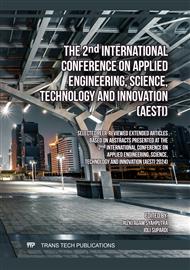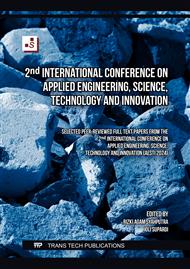[1]
A. Gupta, D. Castro-Fresno, P. Lastra-Gonzalez, and J. Rodriguez-Hernandez, "Selection of fibers to improve porous asphalt mixtures using multi-criteria analysis," Constr. Build. Mater., vol. 266, p.121198, Jan. 2021.
DOI: 10.1016/j.conbuildmat.2020.121198
Google Scholar
[2]
Zukisa, W. Alamsyah, and D. Basrin, "Pengaruh Penambahan Limbah Botol Plastik PET Sebagai Bahan Subtitusi Aspal Porus Penetrasi 60/70," Menara J. Tek. Sipil, vol. 18, no. 2, p.122–129, Jul. 2023.
DOI: 10.21009/jmenara.v18i2.35567
Google Scholar
[3]
S. Chen, L. Gu, Z. Tu, T. Ma, and L. Kang, "Mechanical Properties of Porous Asphalt Mixtures Containing Styrene-Butadiene-Styrene and High-Viscosity Modifiers," J. Mater. Civ. Eng., vol. 35, no. 2, Art. no. 2, Feb. 2023.
DOI: 10.1061/(ASCE)MT.1943-5533.0004495
Google Scholar
[4]
G. Firuliadhim and A. Aszharri, "Karakteristik Campuran Aspal Porous Menggunakan Aspal Modifikasi Cariphalte Dan Penambahan Gilsonite," PILAR, vol. 18, no. 2, p.33–38, 2023.
Google Scholar
[5]
S. M. Saleh, R. Anggraini, and H. Aquina, "Karakteristik Campuran Aspal Porus Dengan Substitusi Styrofoam Pada Aspal Penetrasi 60/70," J. Tek. Sipil, vol. 21, no. 3, p.241–249, 2014.
DOI: 10.24815/jts.v1i3.10011
Google Scholar
[6]
S. Salehi, M. Arashpour, J. Kodikara, and R. Guppy, "Sustainable pavement construction: A systematic literature review of environmental and economic analysis of recycled materials," J. Clean. Prod., vol. 313, p.127936, Sep. 2021.
DOI: 10.1016/j.jclepro.2021.127936
Google Scholar
[7]
Tetra Oktaviani, Dina Tri Septiningtyas, and Wirdatun Nafiah Putri, "Functional Performance of Modified Porous Asphalt Mixtures with Gilsonite Additive," J. Inotera, vol. 9, no. 1, p.184–189, Jun. 2024.
DOI: 10.31572/inotera.Vol9.Iss1.2024.ID342
Google Scholar
[8]
F. Dina, S. M. Saleh, and F. M. Suryani, "Karakteristik Penggunaan Parutan Ban Dalam Bekas Kendaraan Roda 4 Terhadap Campuran AC-BC," vol. 1, no. 1, 2019.
DOI: 10.31602/jk.v4i2.6424
Google Scholar
[9]
H. A. Susanto, B. Mulyono, A. Widyaningrum, and W. Herry Purnomo, "Kinerja Perkerasan Aspal Berpori Dengan Campuran Limbah Plastik Dan Karet," J. Jalan Jemb., vol. 40, no. 1, p.32–43, Jul. 2023.
DOI: 10.58499/jatan.v40i1.1126
Google Scholar
[10]
W. N. H. M. Sani, R. P. Jaya, K. A. Masri, and A. Dulaimi, "The Performance of a Hybrid Asphalt Mixture in Modifying Hot Mix Asphalt Properties," Jun. 11, 2024, In Review.
DOI: 10.21203/rs.3.rs-4494027/v1
Google Scholar
[11]
F. Dina, S. M. Saleh, and F. M. Suryani, "Karakteristik Penggunaan Parutan Ban Dalam Bekas Kendaraan Roda 4 Terhadap Campuran AC-BC," vol. 1, no. 1, 2019.
DOI: 10.31602/jk.v4i2.6424
Google Scholar
[12]
B. Abd. Razak and A. Erdiansa, "Karakteristik Campuran AC-WC dengan Penambahan Limbah Plastik Low Density Polyethylene (LDPE)," INTEK J. Penelit., vol. 3, no. 1, p.8–14, Apr. 2016.
DOI: 10.31963/intek.v3i1.9
Google Scholar
[13]
A. A. Milad, A. S. B. Ali, and N. I. M. Yusoff, "A review of the utilisation of recycled waste material as an alternative modifier in asphalt mixtures," Civ. Eng. J., vol. 6, p.42–60, 2020.
DOI: 10.28991/cej-2020-sp(emce)-05
Google Scholar
[14]
D. Kong, Y. Xiao, S. Wu, N. Tang, J. Ling, and F. Wang, "Comparative evaluation of designing asphalt treated base mixture with composite aggregate types," Constr. Build. Mater., vol. 156, p.819–827, Dec. 2017.
DOI: 10.1016/j.conbuildmat.2017.09.020
Google Scholar
[15]
G. Firuliadhim and A. Aszharri, "Karakteristik Campuran Aspal Porous Menggunakan Aspal Modifikasi Cariphalte Dan Penambahan Gilsonite".
Google Scholar
[16]
S. Tamalkhani, "Effect of oil palm fiber on some physical properties of porous asphalt/Tamalkhani Syammaun," University of Malaya, 2013.
Google Scholar
[17]
AAPA, Open Graded Asphalt Design Guide. Asphalt Pavement Association. Australia. 2004.
Google Scholar
[18]
M. A. H. Al-Jumaili, "Laboratory evaluation of modified porous asphalt mixtures," Appl Res J, vol. 8, p.2–3, 2016.
Google Scholar
[19]
S. R. Harnaeni, P. R. Lestari, R. P. Balich, and G. Aulia, "Komparasi Karakteristik Marshall AC-BC dengan Penggunaan Limbah Ban Luar dan Limbah Steel Slag sebagai Pengganti Agregat Kasar," JRST J. Ris. Sains Dan Teknol., vol. 6, no. 2, p.211, Nov. 2022.
DOI: 10.30595/jrst.v6i2.15355
Google Scholar
[20]
Y. Cheng, C. Chai, Y. Zhang, Y. Chen, and B. Zhu, "A New Eco-Friendly Porous Asphalt Mixture Modified by Crumb Rubber and Basalt Fiber," Sustainability, vol. 11, no. 20, p.5754, Oct. 2019.
DOI: 10.3390/su11205754
Google Scholar
[21]
M. Y. Saputra, M. Agustien, and E. Kadarsa, "The Effect of Addition LDPE Plastic on Porous Asphalt Mixture," Reka Buana J. Ilm. Tek. Sipil Dan Tek. Kim., vol. 8, no. 1, p.88–100, Mar. 2023.
DOI: 10.33366/rekabuana.v8i1.4607
Google Scholar
[22]
P. Lastra-González, E. Lizasoain-Arteaga, D. Castro-Fresno, and G. Flintsch, "Analysis of replacing virgin bitumen by plastic waste in asphalt concrete mixtures," Int. J. Pavement Eng., vol. 23, no. 8, p.2621–2630, 2022.
DOI: 10.1080/10298436.2020.1866760
Google Scholar
[23]
A. I. Candra, S. W. Mudjanarko, Y. C. S. Poernomo, and P. Vitasmoro, "Analysis of the ratio of coarse aggregate to porous asphalt mixture," in Journal of Physics: Conference Series, IOP Publishing, 2020, p.042029.
DOI: 10.1088/1742-6596/1569/4/042029
Google Scholar
[24]
G. M. Duarte and A. L. Faxina, "Asphalt concrete mixtures modified with polymeric waste by the wet and dry processes: A literature review," Constr. Build. Mater., vol. 312, p.125408, 2021.
DOI: 10.1016/j.conbuildmat.2021.125408
Google Scholar
[25]
G. M. Duarte and A. L. Faxina, "Asphalt concrete mixtures modified with polymeric waste by the wet and dry processes: A literature review," Constr. Build. Mater., vol. 312, p.125408, Dec. 2021.
DOI: 10.1016/j.conbuildmat.2021.125408
Google Scholar
[26]
A. Setyawan, "Design and properties of hot mixture porous asphalt for semi-flexible pavement applications," J. Penelit. Media Tek. Sipil Ed. Juli, 2005.
Google Scholar



